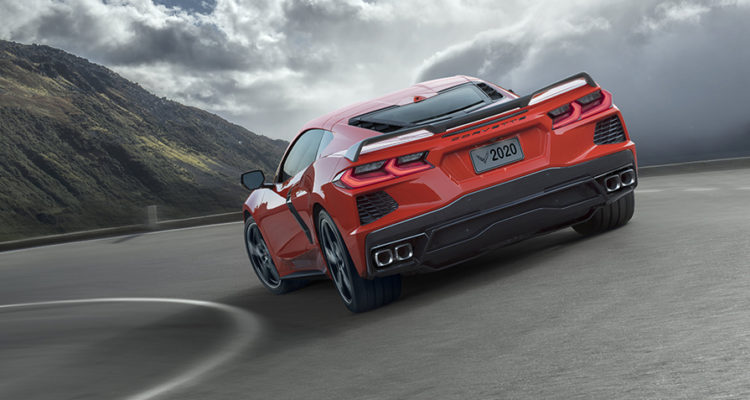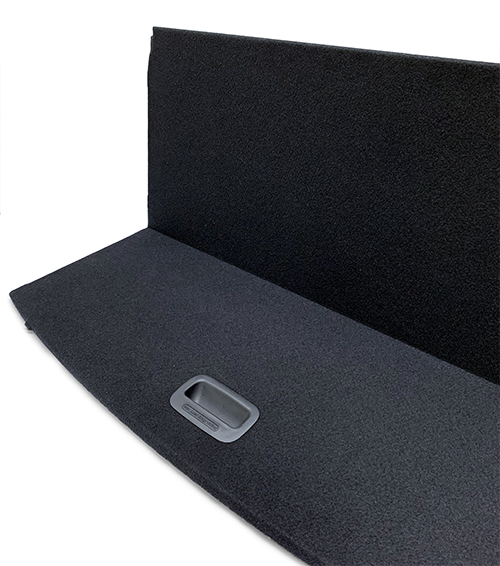Teijin’s proprietary, carbon fiber nylon thermoplastic material, Sereebo®, which makes up the CarbonPro headboard, wall and floor panels, offers more than just strength. It also reduces weight on the Sierra pickups by 25% compared to a traditional steel bed. Those weight savings add up further upon factoring in that the scratch- and dent-resistant bed eliminates the need for a 40-pound bed liner.
CFRTP’s formability allowed engineers to push out the sidewalls further, providing a full cubic foot more cargo room compared to a roll-formed steel bed. That moldability also presented GM with a unique level of design flexibility. GM engineers opted to mold into the box unique features, including tie-downs and indentations for bike storage, as well as a 3-dimensional “grain” to increase traction. In fact, as other automotive manufacturers are discovering, composites’ moldability presents a number of unique aesthetic and functional possibilities that simply aren’t possible with other materials.
Composite Engine Shroud Quiets Cabins
The moldability of composites helped Ford develop a unique solution to its noise challenge. Like other OEMs, Ford has a close eye on lightweighting opportunities, but it’s also focusing on the overall driving experience, including noise. Research on how to improve comfortability led the manufacturer to consider strategies for reducing powertrain noise, vibration and harshness (NVH) inside the vehicle cab. In fact, that’s the entire goal of the NVH Lab Ford launched in Dearborn, Mich.
The lab allows engineers to test vehicle sound in different settings, including a reverberation suite and a semi-anechoic chamber – a room where sound reflections only come from the floor, not the absorbent walls and ceilings – with powered rollers that simulate road noise. The semi-anechoic chamber provides an area free of echo and reverberation and creates a pure working environment for sound, while the reverberation suite is used to determine how noise permeates full components or materials, such as sheet metal. The lab also runs tests in temperatures ranging from -40 to 140 F to develop a stronger understanding of how material shrinkage and expansion may cause squeaks and rattles.
CSP was invited to the NVH lab as it worked with Ford to develop a thermoset sheet molding compound (SMC) for an engine shroud designed specifically to tackle the issue of noise and vibration. Ford had determined that separating the engine compartment from passengers with two walls could help reduce traveling sound in its 2020 Ford Explorer and Lincoln Aviator. The engine shroud mimics a semi-anechoic chamber similar to those used at Ford’s NVH testing lab.
CSP ultimately settled upon a vinyl ester-based SMC material with a high fiberglass content that it engineered using a compression molding process to meet the mass/density, NVH requirements, thermal properties and structural demands of the application. The resulting engine shroud creates an air gap between the engine compartment and the steel front bulkhead. It wraps around the back of the engine to meet the stabilizing strut towers on each side of the engine bay.
This form wouldn’t have been possible using traditional materials, says Bryan Ludwig, business development director at CSP. “Because our glass fiber composite is a thermoset, it actually offers better thermal properties than a metal and can be molded thin enough to fit in the tight spaces found in the engine compartment,” he explains.
Thermal protection is critical, as the engine shroud helps dismiss the excess heat generated by the engine to protect electrical components. Of course, by using a composite material like CSP’s proprietary material within one of those walls separating the engine from passengers, the manufacturer could also reduce the weight of adding additional components. At 12 pounds, the 4-piece assembly is lighter than a similar shroud stamped from steel.
Curving a Pultruded Bumper Beam
Chevrolet calls its 2020 Stingray the fastest, most powerful base model Corvette to date, capable of achieving 0 to 60 mph speed in under three seconds. It gets that speed in part from the expansive use of lightweight materials throughout its body. Much attention has been paid in the automotive industry press to the use of an ultra-lightweight float material used to fabricate the trunk tubs and dashboard. The float material is a fiberglass and proprietary resin SMC from Molded Fiber Glass Co. that’s reportedly so light it can float in water. However, the 2020 Stingray’s multi-hollow pultruded carbon fiber bumper beam demonstrates the strength that composite materials carry with that light weight.
Photo Credit: Ford
The shape of bumper beams play a role in their crashworthiness. Researchers with the University of Turin and Michigan State University have found that in composite bumper beam development, choice of curvature radius improves vehicle aerodynamics and architecture and can contribute to vehicle safety. Changing the material and beam curvature affect the stress distribution along the beam, as well as the stress values. Getting this change right provided Grand Haven, Mich.-based composite engineering firm Shape Corp. an opportunity to innovate.
Paul Roehm, product development engineer for advanced product development at Shape Corp., says the composite engineering company was already exploring advanced development efforts into pultrusion when approached by GM. The OEM was interested in using a composite solution to reduce the weight of the Stingray while meeting tough performance requirements.
The team ultimately chose a blend of carbon fiber and Scott Bader’s Crestapol® urethane acrylate resins to achieve the right balance of strength and lightweight properties for the bumper beam. In collaboration with Germany-based fiber composite pultrusion company Thomas Technik + Innovation, Shape engineers began prototyping pultruded profiles. The engineers started with straight profiles to develop an initial understanding of the manufacturing process and resulting product attributes before pushing for the industry’s first curved pultruded profile.
“In addition to the required quality and complexity of the targeted profile, with its multi-hollow design and thin walls, we also needed to be able to make the pultruded profile with curvature for our targeted application, something not done in the industry today,” explains Joe Matecki, Shape advanced product development product manager.
To create the curved profile, the engineering team had to rethink the standard pultrusion process. “In typical straight pultrusion, the grippers move to constantly pull the part,” explains Roehm. “To add curvature in thermosets, the part needs to be cured in a curved state.” The bumper beam production cell developed by Thomas Technik uses a curved, moving die to pull the part and a stationary gripper.
Photo Credit: EconCore
The finished bumper beam was to be bonded to the steel structure at the rear of the car, yet this presented another challenge. Several structural adhesives were tested to find the best combination of strength and toughness to meet the crash, impact and durability requirements necessary to achieve Chevrolet’s standards, as well as the high temperatures of the electrophoretic coating process, the finishing process used for steel components. To assemble the bumper beam on the manufacturing line, it had to withstand this tough primary finishing process. The team selected Crestabond® M7-05 in part due to its ability to bond under the high-temperature test protocol. Not only was the finished part able to achieve stringent Class A surfacing requirements, but it was able to do so on the primary manufacturing line.




